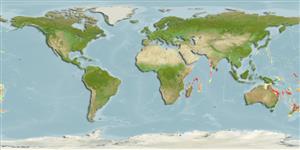Common names from other countries
Classification / Names / Names
Populaire namen | Synoniemen | Catalog of Fishes (gen., sp.) | ITIS | CoL | WoRMS
Environment: milieu / climate zone / depth range / distribution range
Ecologie
; diepteverspreiding 33 - 550 m (Ref. 8366). Subtropical
Southern Atlantic to Indo-Pacific: South Africa to New Zealand and throughout Southern Ocean.
Length at first maturity / Size / Gewicht / Leeftijd
Maturity: Lm ? range ? - ? cm Max length : 3.8 cm TL mannelijk/geslacht niet bekend; (Ref. 8366); 5.8 cm TL (female); common length : 2.4 cm TL mannelijk/geslacht niet bekend; (Ref. 8366); common length :3.78 cm TL (female)
Minimum depth from Ref. 3113.
Life cycle and mating behavior
Geslachtsrijpheid | Voortplanting | Kuitschieten | Eieren | Fecundity | Larven
Members of the order Isopoda are mostly gonochoric. Mating behavior: Mating usually occurs before and sometimes during the parturial molt. Sperm transfer is indirect. Life cycle: Eggs are brooded in the marsupium, which later hatch into manca postlarva before developing into adults.
Schotte, M., B.F. Kensley and S. Shilling. 1995. (Ref. 3113)
Status op de Rode Lijst van het IUCN (Ref. 130435)
Status bij CITES (Ref. 108899)
Not Evaluated
Not Evaluated
Gebruik door de mens
| FishSource |
Tools
Meer informatie
Populaire namenSynoniemenPredatorsVoortplantingGeslachtsrijpheidKuitschietenFecundityEierenOntwikkeling van de eieren
Leeftijd/Grootte
Groei
Lengte-gewicht parameters
Lengte-lengte parameters
Morfologie
Larven
Abundantie
Internet-bronnen
Estimates based on models
Preferred temperature
(Ref.
115969): 12.6 - 23.4, mean 18.8 (based on 99 cells).
Kwetsbaarheid
Low vulnerability (10 of 100).
